seats MERCEDES-BENZ GL SUV 2012 Owners Manual
[x] Cancel search | Manufacturer: MERCEDES-BENZ, Model Year: 2012, Model line: GL SUV, Model: MERCEDES-BENZ GL SUV 2012Pages: 441, PDF Size: 10.66 MB
Page 6 of 441
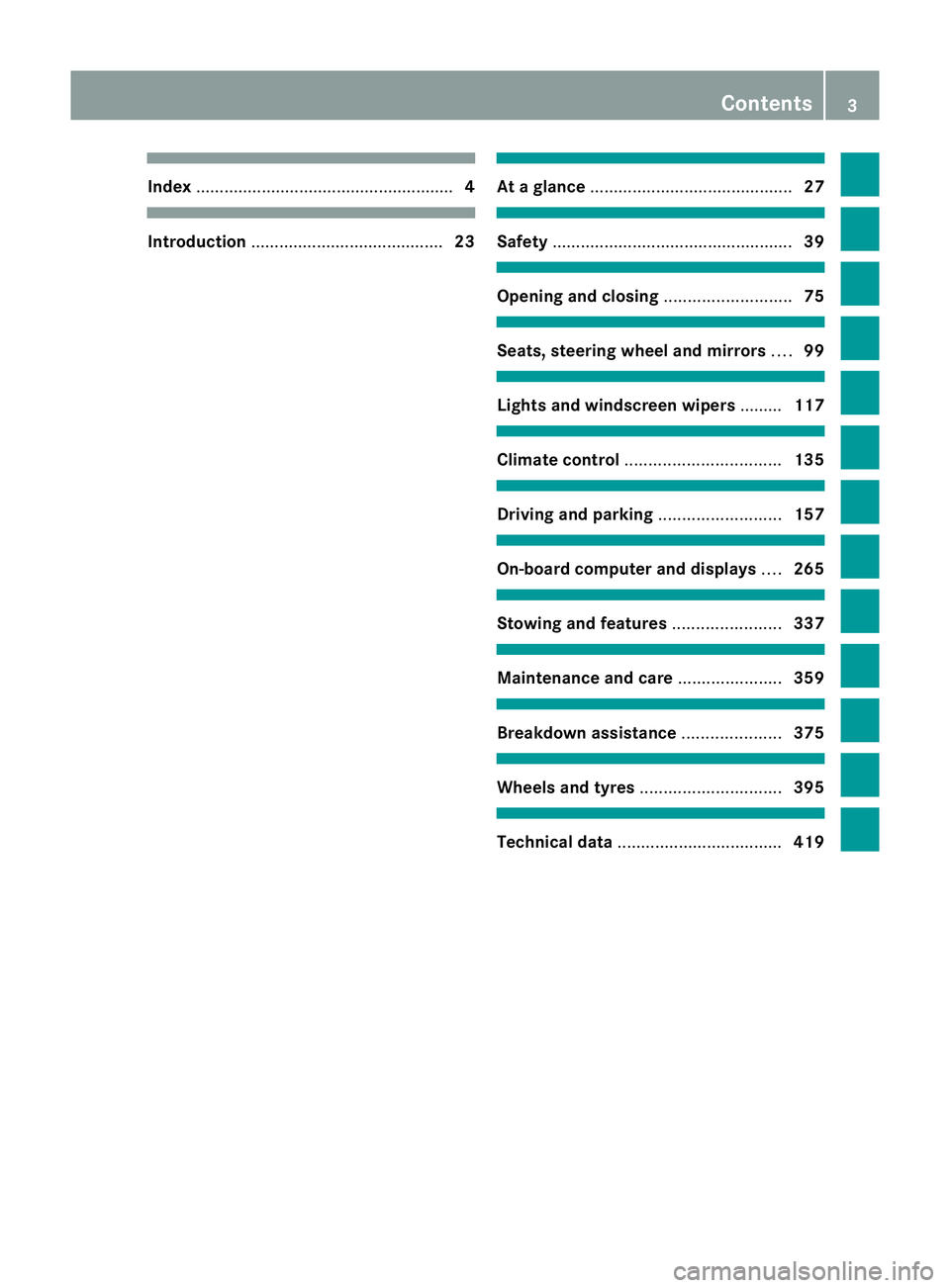
Index
........................ ............................... 4 Introduction
......................................... 23 At
ag lance ........................................... 27 Safety
................................................... 39 Opening and closing
...........................75 Seats, steering wheel and mirrors
....99 Light
sand windscreen wipers .........117 Clima
tecontrol ................................. 135 Driving and pa
rking .......................... 157 On-boa
rdcomputer and displays ....265 Stowing and fea
tures....................... 337 Maintenance and care
......................359 Breakdown assistance
.....................375 Wheels and ty
res.............................. 395 Technical da
ta................................... 419 Contents
3
Page 11 of 441
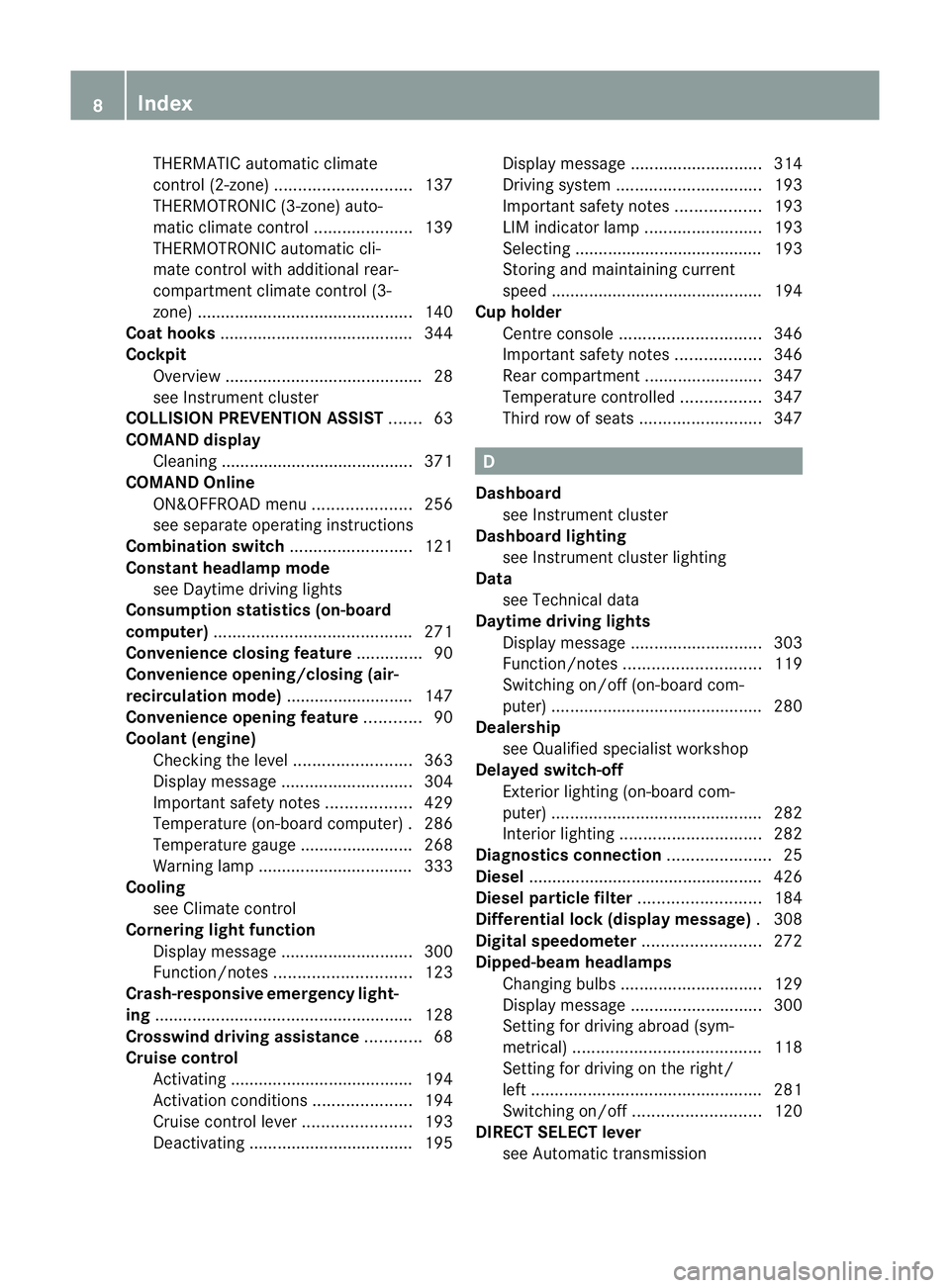
THERMATIC automatic climate
control (2-
zone) ............................. 137
THERMOTRONIC (3-zone) auto-
mati cclimate control ..................... 139
THERMOTRONIC automatic cli-
mate control with additiona lrear-
compartmen tclimate control (3-
zone) ............................................. .140
Coat hooks ......................................... 344
Cockpit Overview .......................................... 28
se eI nstrument cluster
COLLISIO NPREVENTION ASSIST .......63
COMAND display Clean ing. ........................................ 371
COMAND Online
ON&OFFROAD menu .....................256
se es eparat eoperating instructions
Combination switch ..........................121
Constant headlamp mode seeD aytime driving lights
Consumption statistic s(on-boa rd
computer) .......................................... 271
Conv enienc eclosin gfeature .............. 90
Conv enienc eopening/closing (air-
recirculation mode) ........................... 147
Conv enienc eopening feature ............90
Coolan t(engine)
Checkin gthe level ......................... 363
Display message ............................ 304
Important safety notes ..................429
Temperat ure( on-board computer) .286
Temperat ureg auge ........................ 268
Warning lamp ................................. 333
Cooling
see Climate control
Cornerin glight function
Display message ............................ 300
Function/notes ............................. 123
Crash-respon siveemergency light-
ing ...................................................... .128
Cro sswind drivin gassistance ............68
Crui secontrol
Activating ............. .......................... 194
Activatio ncondition s..................... 194
Cruis econtrol lever ....................... 193
Deactivating ................................... 195 Display message
............................ 314
Driving sy stem ............................... 193
Important safety notes ..................193
LIM ind icator lamp ......................... 193
Selecting ........................................ 193
Storing and maintaining current
spee d............................................. 194
Cu ph older
Centre console .............................. 346
Important safety notes ..................346
Rea rcompartmen t......................... 347
Temperat urec ontrolled ................. 347
Th irdr ow of seats .......................... 347 D
Dashboard seeI nstrument cluster
Dashboard lighting
see Instrument cluster lighting
Data
see Technical data
Daytime drivi nglights
Display message ............................ 303
Function/notes ............................. 119
Switch ingo n/off (on-board com-
puter) ............................................. 280
Dealer ship
see Qualified specialis tworkshop
Delayed switch-off
Exterior lighting (on-board com-
pute r)............................................. 282
Interior lighting .............................. 282
Diagn ostic sc onnec tion...................... 25
Dies el................................................. .426
Dies elparticl efilter .......................... 184
Differential loc k(display message) .308
Digital spe edometer ......................... 272
Dipped-b eamh eadlamps
Changing bulbs .............................. 129
Display message ............................ 300
Setting for driving abroa d(sym-
metrical) ........................................ 118
Setting for driving on the rig ht/
left ................................................. 281
Switch ingo n/off ........................... 120
DIRECT SE LECT lever
se eA utomatic transmission 8
Index
Page 21 of 441
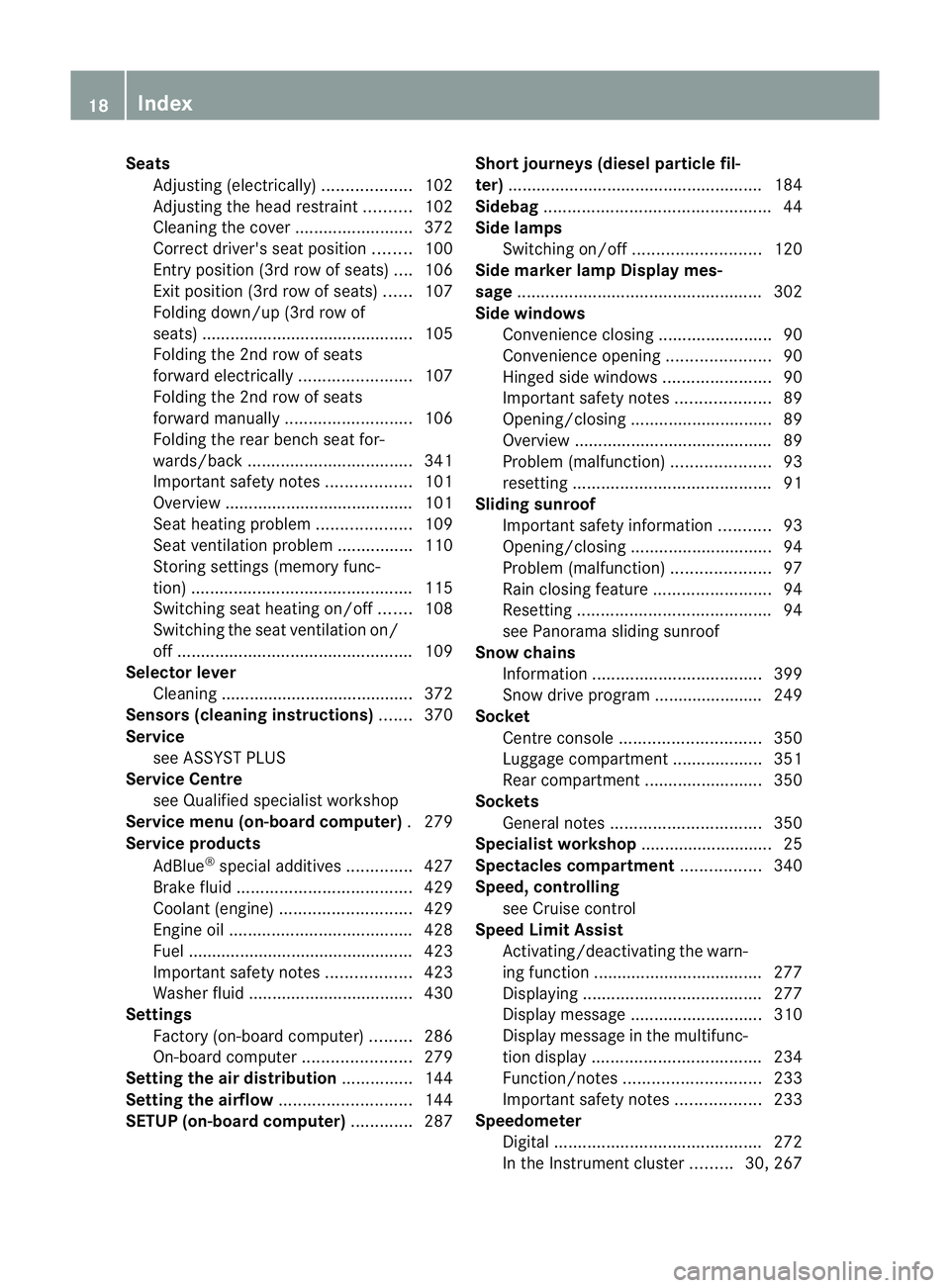
Seats
Adjusting (electrically) ...................102
Adjusting the he adrestraint ..........102
Clean ingt he cover ......................... 372
Correct driver's se at position........100
Entry positio n(3rd row of se ats)....106
Exit positio n(3rd row of se ats)...... 107
Fol ding down/up (3rd row of
seats) ............................................ .105
Fol ding the 2nd row of seats
forward electrically ........................107
Fol ding the 2nd row of seats
forward manually ........................... 106
Fol ding the rear bench sea tfor-
wards/bac k................................... 341
Important safety notes ..................101
Overview ........................................ 101
Sea theating problem ....................109
Sea tventil ation proble m................ 110
Storing settings (memory func-
tion) ............................................... 115
Switch ings eat heating on/off .......108
Switch ingt he seat ventilation on/
off .................................................. 109
Se lect or lever
Cleaning ......................................... 372
Sensors (cleaning instructions) .......370
Service seeA SSYST PLUS
Serv iceC ent re
see Qualified specialist workshop
Serv icem enu (on-board computer) .279
Service products
AdBl ue®
special additive s.............. 427
Brake fluid ..................................... 429
Co olan t(engine) ............................ 429
Engine oi l....................................... 428
Fue l................................................ 423
Important safety note s.................. 423
Washe rfluid .................................. .430
Settings
Factory (on-bo ardc omputer )......... 286
On-bo ardc omputer ....................... 279
Settin gthe air distribution ...............144
Settin gthe airfl ow............................ 144
SETUP (on-b oard computer) .............287Short journey
s(diesel particl efil-
ter) ...................................................... 184
Sidebag ................................................ 44
Side lamps Switch ingo n/off ........................... 120
Side marker lamp Display mes-
sage .................................................... 302
Side windo ws
Convenience closing ........................90
Convenience opening ......................90
Hinged si de window s....................... 90
Important safety notes ....................89
Opening/closing .............................. 89
Overview .......................................... 89
Pro blem (malfunction) ..................... 93
resetting .......................................... 91
Sl iding sunroof
Important safety information ...........93
Opening/closing .............................. 94
Pro blem (malfunction) ..................... 97
Rain closing feat ure. ........................ 94
Resetting ......................................... 94
se eP anorama sliding sunroof
Sno wchains
Information .................................... 399
Sno wdrive program ....................... 249
So cket
Centre console .............................. 350
Luggag ecompartmen t................... 351
Rea rcompartmen t......................... 350
So ckets
General notes ................................ 350
Spe cialist workshop ............................ 25
Spe ctacle scom partment ................. 340
Spe ed,cont rolling
see Cruise control
Spee dLimit Assist
Activating/deactivatin gthe warn-
ing function .................................... 277
Displayi ng...................................... 277
Display message ............................ 310
Display message in the multifunc-
tio nd ispla y.................................... 234
Function/notes ............................. 233
Important safety notes ..................233
Spe edometer
Digita l............................................ 272
In the Instrumen tcluster ......... 30, 267 18
Index
Page 45 of 441
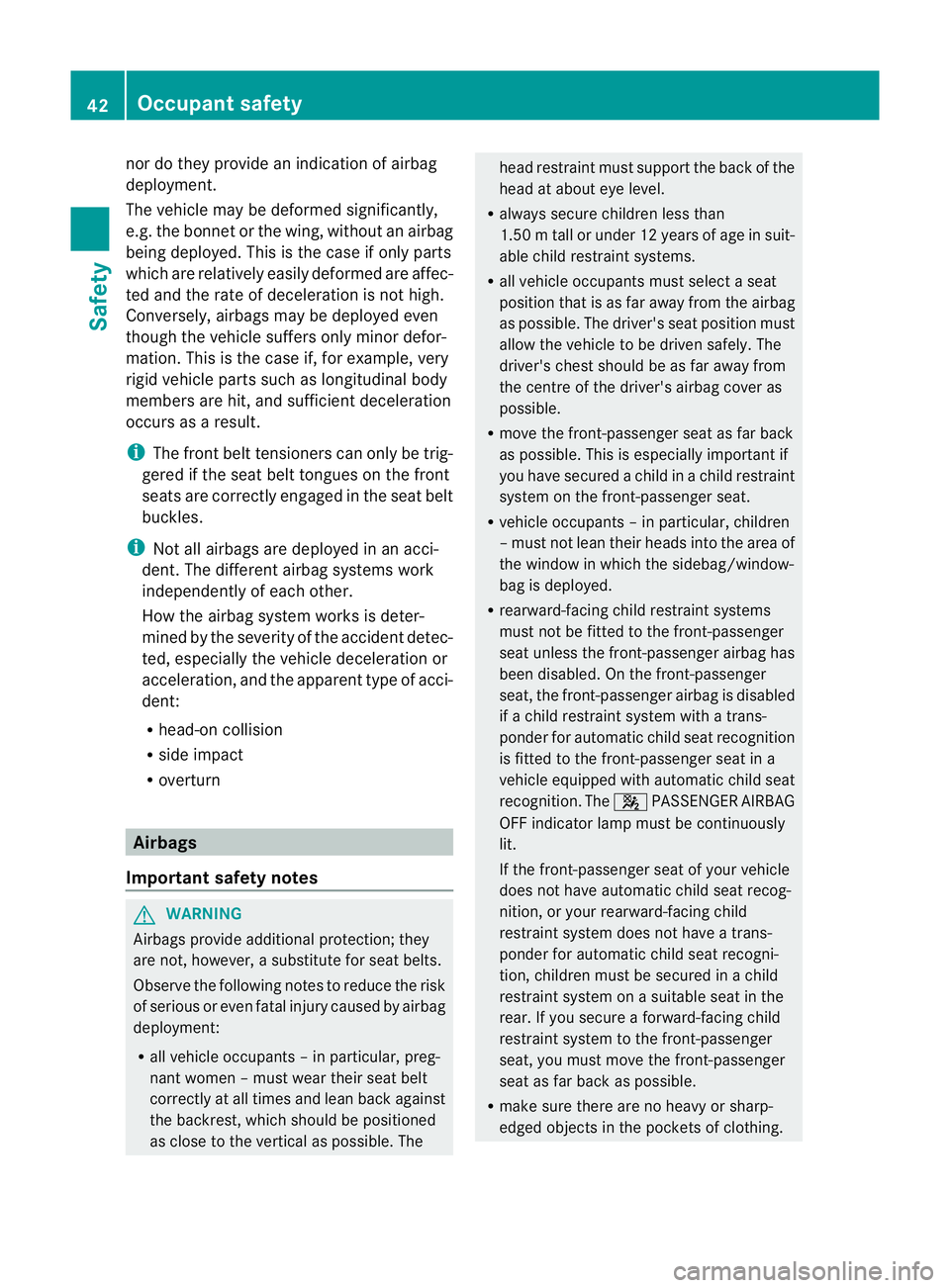
nor do they provid
eanindicatio nofairbag
deployment.
The vehicle may be deformed significantly,
e.g. the bonnet or the wing, withou tanairbag
being deployed. This is the case if only parts
which are relatively easily deformed are affec-
ted and the rat eofdeceleration is not high.
Conversely, airbags may be deployed even
though the vehicle suffers only minor defor-
mation. This is the case if, for example, very
rigid vehicle part ssuch as longitudinal body
members are hit, and sufficien tdeceleration
occu rsas aresult.
i The fron tbelt tensioners can only be trig-
gered if the seat belt tongues on the front
seats are cor rectly engage dinthe seat belt
buckles.
i Not all airbags ar edeployed in an acci-
dent .The different airbag system swork
independently of each other.
How the airbag system work sisdeter-
mined by the severity of the accident detec-
ted, especially the vehicle deceleration or
acceleration, and the apparent type of acci-
dent:
R head-on collision
R side impact
R overturn Airbags
Important safety notes G
WARNING
Airbags provide additional protection; they
are not, however ,asubstitute for seat belts.
Observe the following notes to reduce the risk
of serious or even fatal injury caused by airbag
deployment:
R all vehicle occupants –inparticular ,preg-
nant women –must wear their seat belt
correctly at all times and lean back against
the backrest, which should be posi tioned
as close to th evertical as possible. The head restraint must support th
eback of the
head at about eye level.
R always secur echildren less than
1.50 mtall or under 12 years of age in suit-
able child restraint systems.
R all vehicle occupant smust select aseat
position that is as far away from the airbag
as possible. The driver' sseat position must
allow the vehicle to be driven safely .The
driver's chest should be as fa raway from
the centre of the driver' sairbag cover as
possible.
R move the front-passenger seat as far back
as possible .This is especially important if
you hav esecured achild in achild rest raint
system on the front-passenger seat.
R vehicle occupant s–inparticular ,children
–m ust not lean their heads into the area of
the window in which the sidebag/window-
bag is deployed.
R rearward-facing child restraint systems
must not be fit tedtot he front-passenger
seat unless the front-passenger airbag has
been disabled. On the front-passenger
seat, the front-passenger airbag is disabled
if ac hild rest raint system with atrans-
ponde rfor automatic child seat recognition
is fit tedtot he front-passenger seat in a
vehicle equipped with automatic chil dseat
recognition. The 4PASSENGE RAIRBAG
OF Findicator lamp must be continuously
lit.
If the front-passenger sea tofyour vehicle
does not have automatic child seat recog-
nition ,oryour rearward-facing child
rest raint system does not have atrans-
ponde rfor automatic child seat recogni-
tion ,children must be secured in achild
rest raint system on asuitable seat in the
rear. If you secure aforward-facing child
rest raint system to the front-passenger
seat, you must move the front-passenger
seat as far back as possible.
R make sure there are no heavy or sharp-
edged objects in the pockets of clothing. 42
Occupant safetySafety
Page 48 of 441
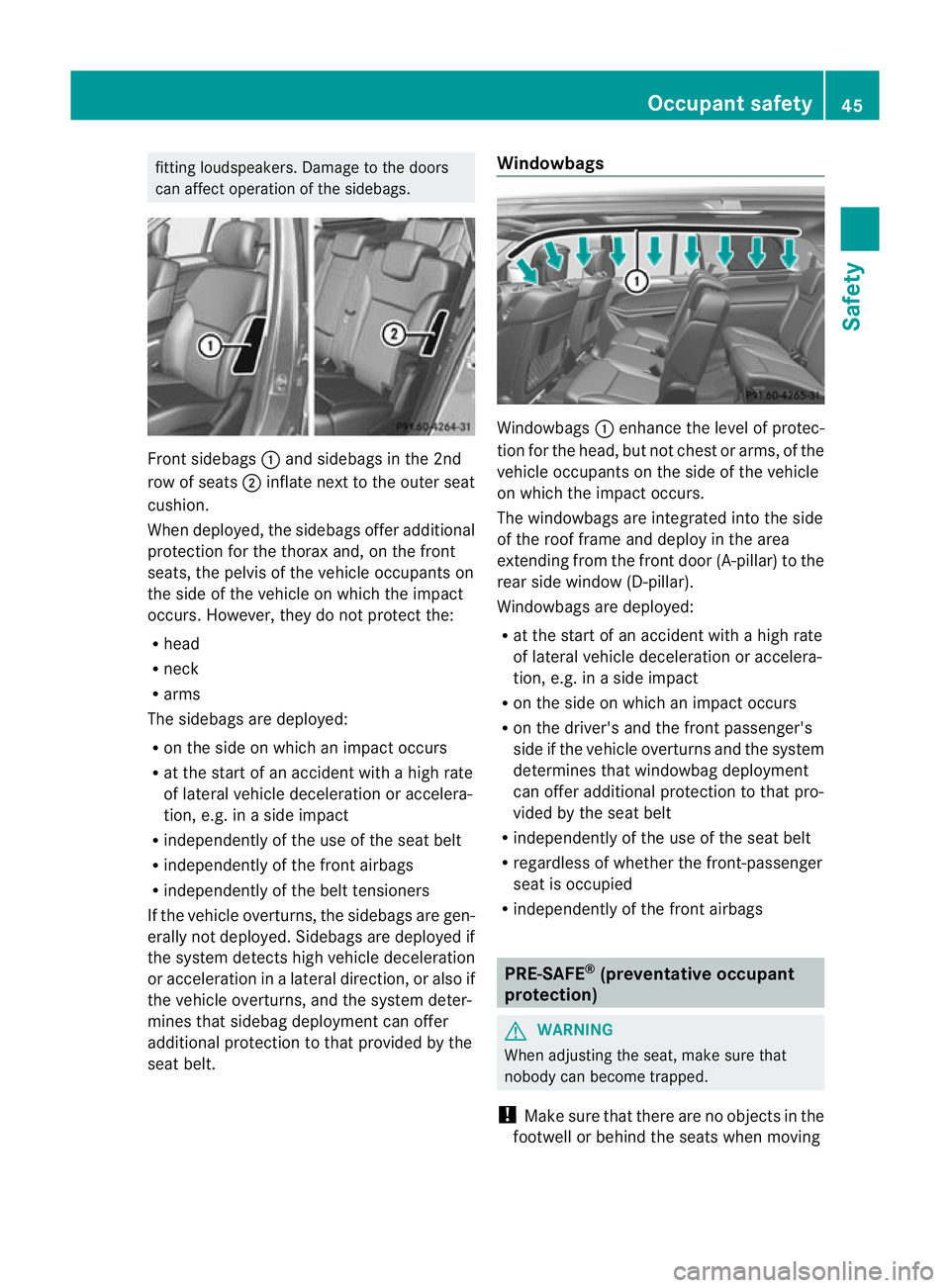
fitting lo
udspeakers. Damag etothe doors
can affec toperation of the sidebags. Front sidebags
:and sidebag sinthe 2nd
row of seats ;inflate nex ttothe outer seat
cushion.
When deployed, the sidebag soffer additional
protectio nfor the thorax and, on the front
seats, the pelvis of the vehic leoccupants on
the side of the vehic leon which the imp act
occurs. Howev er,they do not protect the:
R head
R neck
R arms
The sidebag sare deploy ed:
R on the side on which an imp acto ccurs
R at the start of an accident with ahigh rate
of lateral vehicle deceleration or accelera-
tion, e.g. in aside impact
R independently of the use of the sea tbelt
R independently of the fron tairbags
R independen tlyo fthe belt tensioners
If the vehi cleo verturns, th esidebags are gen-
erally not deployed. Sidebags are deployed if
the system detects high vehicle deceleration
or acceleration in alatera ldirection, or als oif
the vehicl eoverturns ,and the system deter-
mines that sid ebag deployment can offer
additiona lprotectio ntothat provided by the
seat belt. Windowbags
Windo
wbags :enhance the leve lofprotec-
tio nfor the head, but not chest or arms, of the
vehicle occupants on the side of the vehicle
on which the impact occurs.
The windowbags ar eintegrate dinto the side
of the roof frame and dep loyint he area
extendin gfrom th efront door (A-pi llar) to the
rear side windo w(D-pillar).
Windo wbagsa re deploy ed:
R at the start of an accident with ahigh rate
of lateral vehicle deceleration or accelera-
tion ,e.g. in asidei mpact
R on th esideonw hich an impact occurs
R on the driver's and the front pass enger's
sid eift he vehicle overturns and the system
determines that windowbag deployment
can off eradditiona lprotectio ntothat pro-
vided by the sea tbelt
R independently of the use of the seat belt
R regardless of whether the front-passenger
seat is occupied
R independently of the fron tairbags PRE-SAFE
®
(preventative occup ant
protection) G
WARNING
Whe nadjusting the seat ,makes ure that
nobody can become trapped.
! Make sure that there are no object sinthe
footwell or behin dthe seat swhen moving Occup
ants afety
45Safety Z
Page 49 of 441
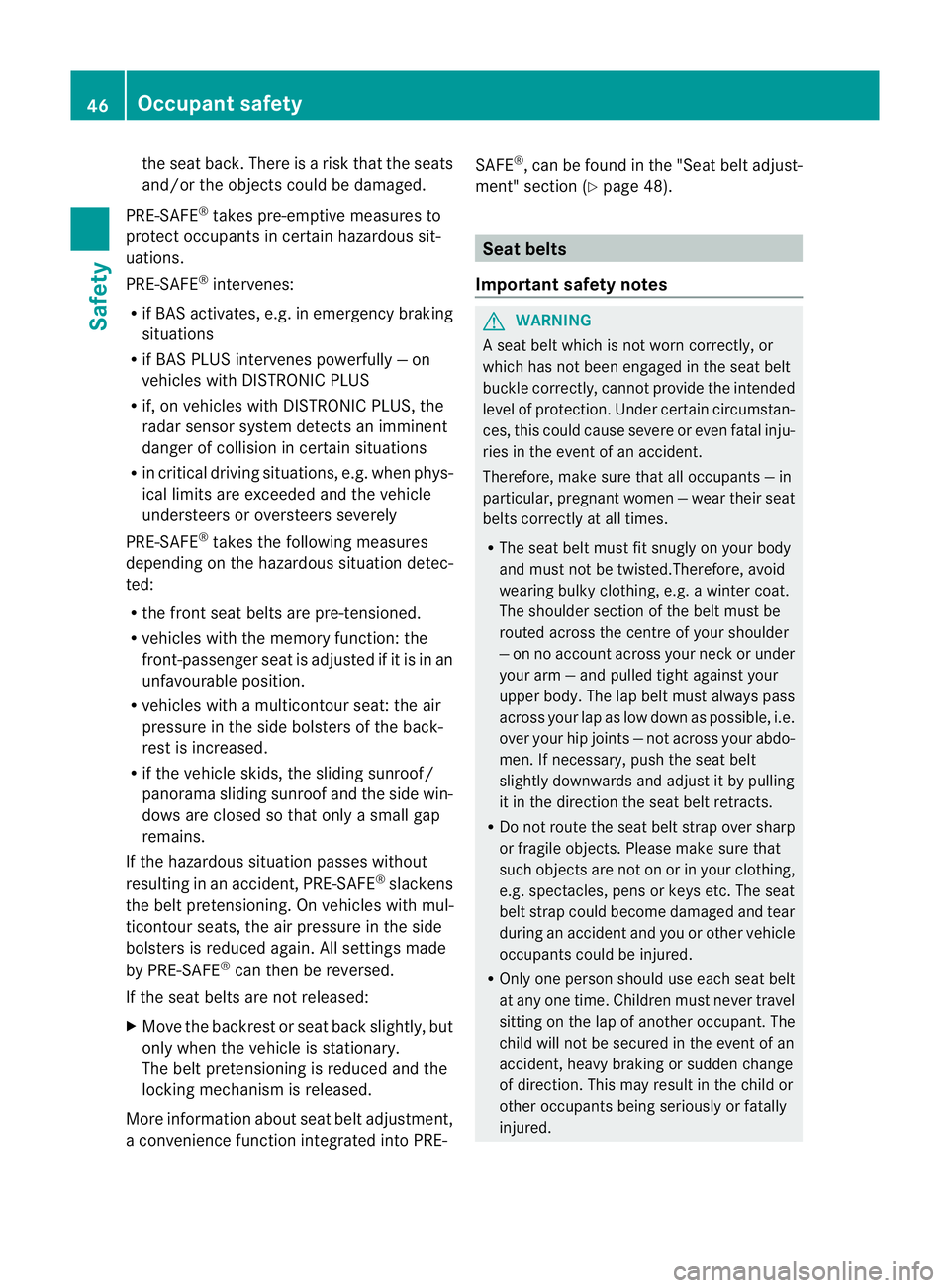
the seat back. There is
arisk thatthe seats
and/or the objec ts could be damaged.
PRE-SAFE ®
takes pre-emptive measures to
protect occupants in certain hazardous sit-
uations.
PRE-SAFE ®
intervenes:
R if BAS activates, e.g. in emergency braking
situations
R if BAS PLUS intervenes powerfull y—on
vehicles wit hDISTRONIC PLUS
R if, on vehicles with DISTRONIC PLUS, the
radar sensor system detects an imminent
dang er of collision in cer tain situations
R in critical drivin gsituations, e.g. when phys-
ical limits are exceeded and the vehicle
understeers or oversteers severely
PRE-SAFE ®
takes the following measures
depending on the hazardous situation detec-
ted:
R the front seat belts are pre-tensioned.
R vehicles with the memor yfunction: the
front-passenger seat is adjusted if it is in an
unfavourable position.
R vehicles with amulticontour seat: the air
pressure in the side bolsters of the back-
rest is increased.
R if the vehicle skids ,the slidin gsunroof/
panorama sliding sunroof and the side win-
dows are closed so that only asmall gap
remains.
If th ehazardous situation passe swithout
resulting in an accident ,PRE-SAFE ®
slackens
the belt pretensioning. On vehicles with mul-
ticontour seats ,the air pressur einthe side
bolster sisreduced again. All settings made
by PRE- SAFE®
can the nbereversed.
If the seat belts are not released:
X Move the backrest or seat back slightly, but
only when the vehicle is stationary.
The belt pretensioning is reduced and the
locki ng mech anism is released.
More information about seat belt adjustment,
ac onvenien ce function integ rated into PRE- SAFE
®
,c an be found in the "Seat belt adjust-
ment "section (Y page 48). Seat belts
Important safety notes G
WARNING
As eat belt which is not worn correctly, or
which has not been engaged in the seat belt
buckle correctly, can notp rovide th eintended
level of protection. Under certain circumstan-
ces, this could cause severe or even fatal inju-
ries in the event of an accident.
Therefore, make sure that all occupants —in
particular ,pregnant women —wear their seat
belts cor rectly at all times.
R Th es eat belt must fit snugly on your body
and must not be twisted.Therefore, avoid
wearing bulky clothing, e.g. awinter coat.
The shoulder section of the belt must be
routed across the centre of your shoulder
—onnoa ccount acros syour nec korunder
your arm —and pulled tight against your
uppe rbody. The lap belt must always pass
across your lap as low down as possible, i.e.
over your hip join ts—n ot across your abdo-
men .Ifn ecessary, push the seat belt
slightly downwards and adjust it by pulling
it in the direction the seat belt retracts.
R Do not rout ethe seat belt strap over sharp
or fragile objec ts.P lease make sure that
such object sare not on or in your clothing,
e.g .spectacles, pens or keys etc. The seat
belt strap could become damaged and tear
durin gana ccident and you or other vehicle
occupants coul dbeinjured.
R Only one person should use each sea tbelt
at any one time. Children must never travel
sittin gont he lap of another occupan t.The
child will not be secured in the even tofan
accident ,heavy braking or sudden change
of direction .This ma yresult in the child or
other occupants being seriously or fatally
injured. 46
Occupant safetySafety
Page 51 of 441
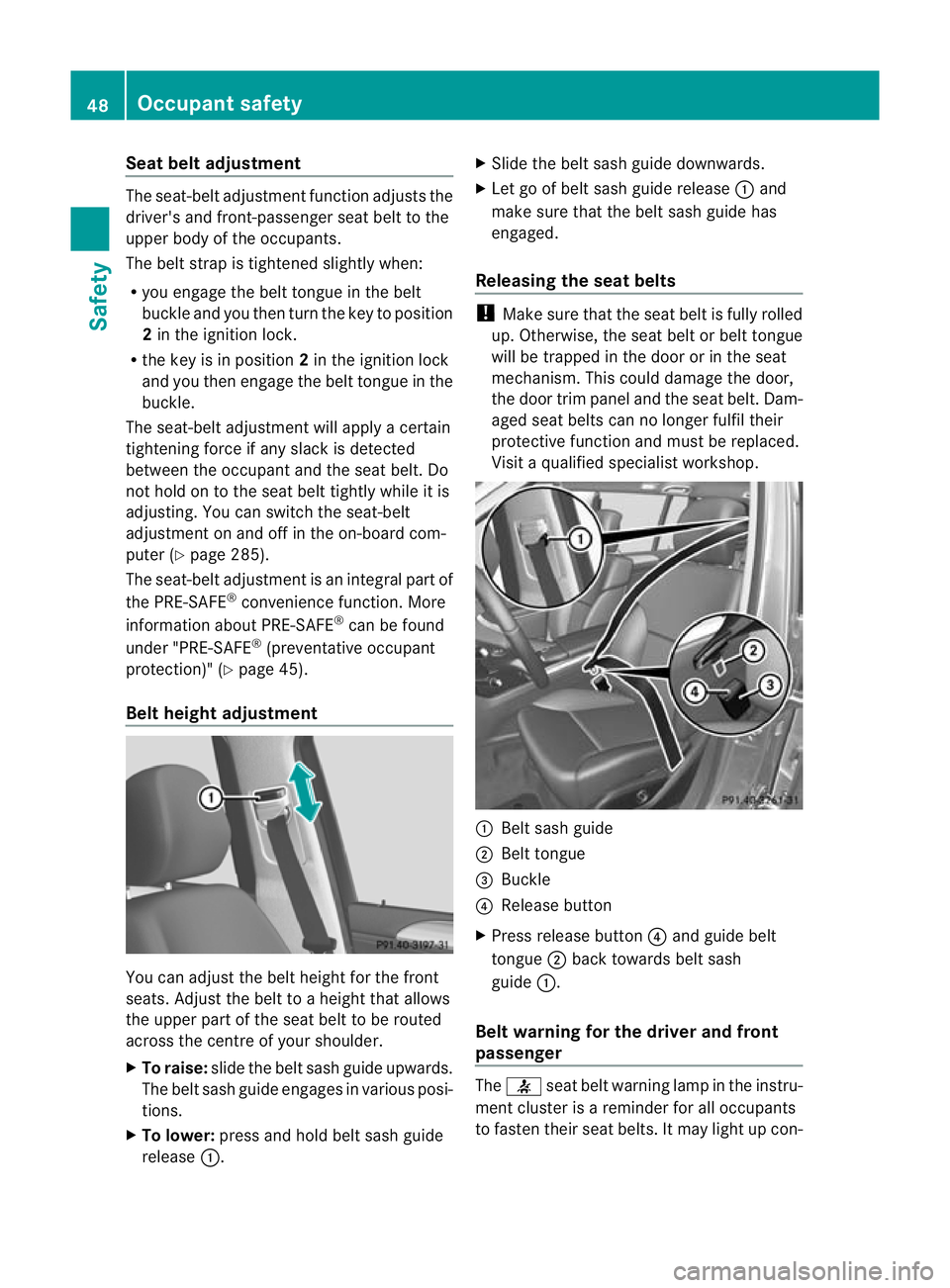
Sea
tbelt adjustment The seat-belt adjustment func
tion adjusts the
driver's and front-passenger seat belt to the
upper body of the occupants.
The belt strap is tighte neds lightly when:
R you engage the belt tongue in the belt
buckle and you then turn the key to position
2in the ignition lock.
R the key is in position 2in the ignition lock
and you then engage the belt tongue in the
buckle.
The seat-belt adjustment will apply acertain
tightening force if any slack is detected
between the occupant and the seat belt. Do
not hold on to the seat belt tightly while it is
adjusting. You can switch the seat-belt
adjustmen tonand off in the on-board com-
puter (Y page285).
Th es eat-belt adjustmen tisani ntegral part of
the PRE-SAFE ®
convenience function. More
information abou tPRE-SAFE ®
can be found
under "PRE-SAFE ®
(preventative occupant
protection)" (Y page 45).
Belt height adjustment You can adjust the belt height for the front
seats
.Adjust the belt to aheight that allows
the upper part of the seat belt to be routed
across the centre of your shoulder.
X To raise: slide the belt sash guide upwards.
The belt sash guide engages in various posi-
tions.
X To lower: press and hold belt sash guide
release :. X
Slide the belt sash guide downwards.
X Let go of belt sash guide release :and
mak esure that the belt sash guide has
engaged.
Releasing the seat belts !
Make sure that the seat belt is fully rolled
up. Otherwise, the seat belt or belt tongue
will be trapped in the door or in the seat
mechanism. This could damage the door,
the door trim panel and the seat belt. Dam-
aged seat belts can no longer fulfil their
protective function and must be replaced.
Visit aqualified specialist workshop. :
Belt sash guide
; Belt tongue
= Buckle
? Release button
X Press release button ?and guide belt
tongue ;back towards belt sash
guide :.
Belt warning for the driver and front
passenger The
7 seat belt warning lamp in the instru-
ment cluster is areminder for all occupants
to fasten their seat belts. It may light up con- 48
Occupant safetySafety
Page 52 of 441
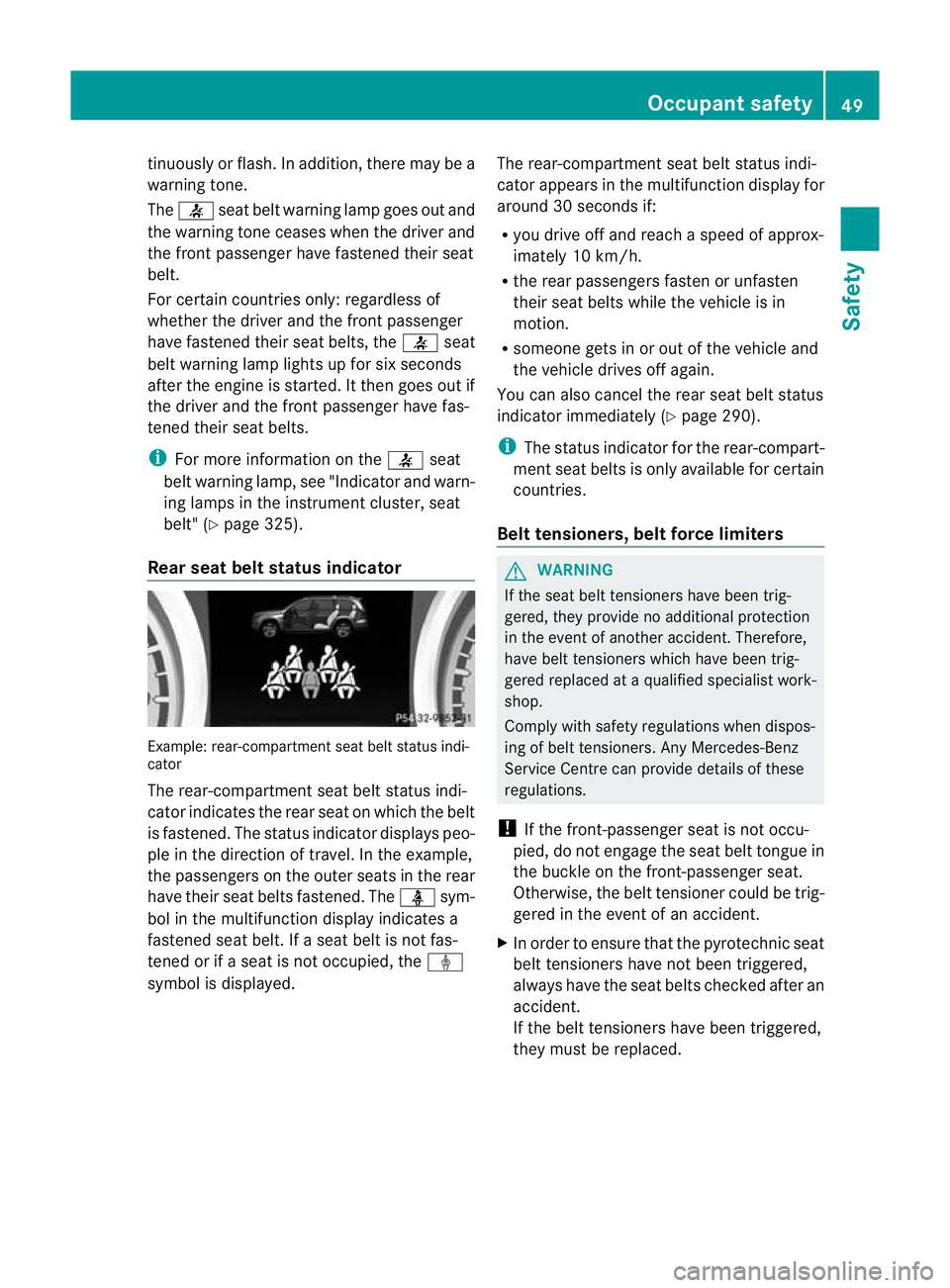
tinuousl
yorflash. In addition, th erem ay be a
warning tone.
The 7 seat belt warning lamp goes ou tand
the warning tone ceases when the driver and
the front pass enger hav efastened their seat
belt.
For certain coun tries only: regardless of
whether th edriver and the front passenger
have fastened their seat belts, the 7seat
bel tw arning lamp lights up for six seconds
after the engin eisstarted. It then goes out if
th ed river and the front passenger have fas-
tened thei rseat belts.
i For mor einformation on the 7seat
bel twarning lamp, see "Indicator and warn-
in gl am ps in the instrument cluster ,seat
belt" (Y page 325).
Rear seat belt status indicator Example: rear-compartment sea
tbelts tatus indi-
cator
The rear-comp artment sea tbelt status indi-
cator indicates the rear seat on which the belt
is fastened. The status indicator displays peo-
ple in the direc tion of travel. In the example,
the passenger sonthe outer seats in the rear
hav etheir seat belts fastened. The üsym-
bol in the multifunction displa yindicates a
fastened sea tbelt. If aseat belt is not fas-
tened or if aseat is not occupied, the ý
symbol is displayed. The rear-compartment seat belt status indi-
cator appear
sint he multifunction displa yfor
around 30 seconds if:
R you drive off and reach aspeed of approx-
imately 10 km/h.
R the rear passengers fasten or unfasten
their seat belts while the vehicle is in
motion.
R someon egets in or out of the vehicle and
the vehicle drives off again.
You can also can celthe rea rseat belt status
indicator immediately (Y page 290).
i The status indicator for the rear- compart-
ment seat belts is only available for certain
countries.
Bel ttensioners, belt force limiters G
WARNING
If the seat belt tensioners have been trig-
gered, they provide no additional protection
in the event of another accident. Therefore,
have belt tensioners which have been trig-
gered replaced at aqualified specialist work-
shop.
Comply with safety regulations when dispos-
ing of belt tensioners. An yMercedes-Benz
Ser vice Centre can provid edetails of these
regulations.
! If the front-passenger seat is not occu-
pied, do not engage the seat belt tongue in
the buckl eonthe front-passenger seat.
Otherwise, the belt tensioner could be trig-
gere dint he even tofanaccide nt.
X In order to ensur ethat the pyrotechnic seat
belt tensioner shave not been triggered,
alway shave the seat belts checked after an
accident.
If the belt tensioners have been triggered,
they must be replaced. Occupant safety
49Safety Z
Page 53 of 441
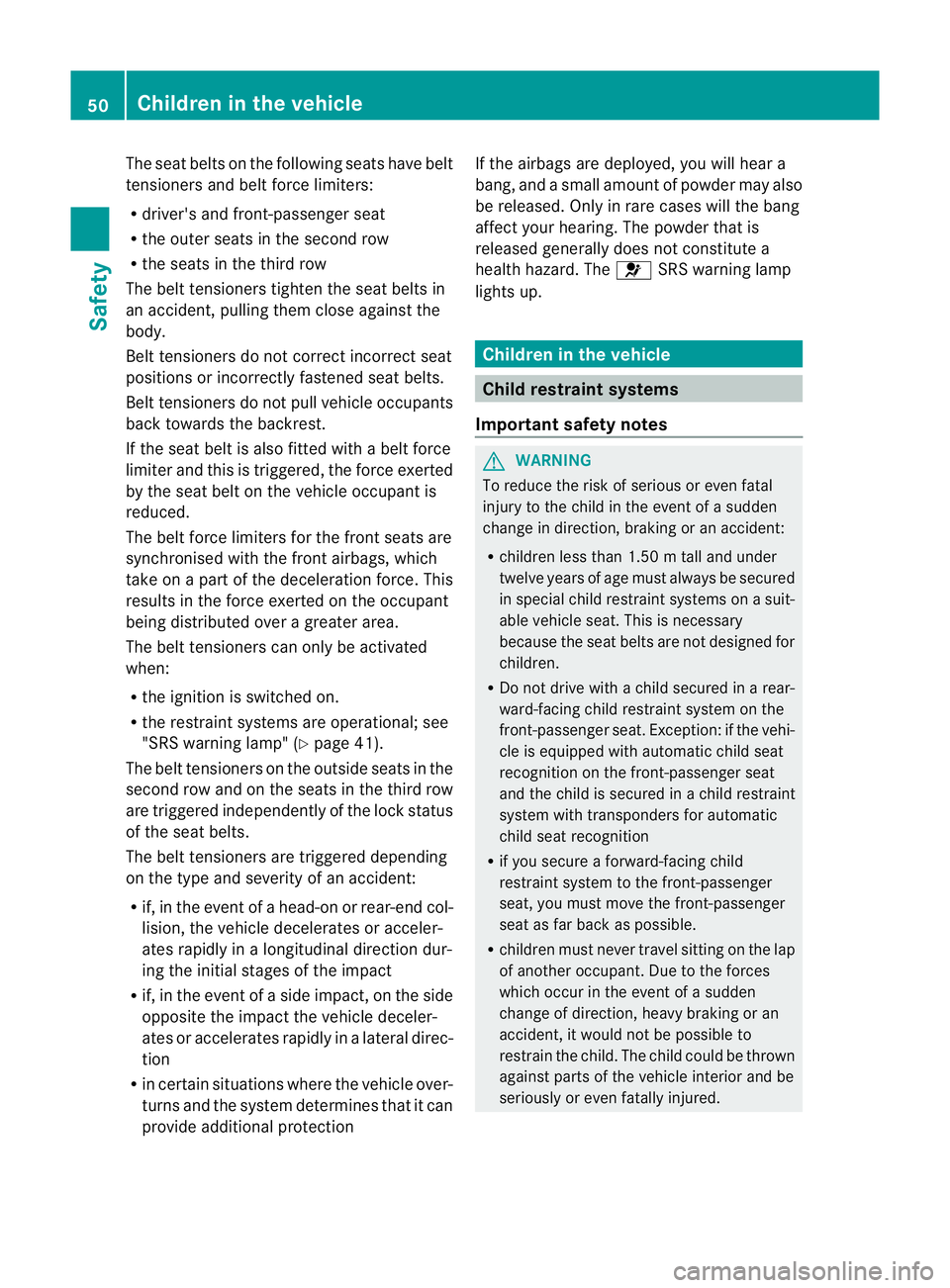
The seat belts on the following seats have belt
tensioner
sand bel tforc elimiters:
R driver's and front-passenger seat
R the outer seats in the second row
R the seats in the third row
The belt tensioners tighten the seat belts in
an accident ,pulling them close against the
body.
Belt tensioners do not correc tincorrect seat
positions or incorrectly fastened sea tbelts.
Belt tensioners do not pull vehicle occupants
back towards the backrest.
If the seat belt is also fit tedw ithabelt force
limiter and this is triggered, the force exer ted
by the seat belt on the vehicle occupant is
reduced.
The belt force limiters for the fron tseats are
synchronised with the fron tairbags, which
tak eona part of the deceleration force. This
result sinthe force exerted on the occupant
being distributed over agrea tera rea.
Th eb elt tensioners can only be activa ted
when:
R the ignition is switched on.
R the restraint system sare opera tional; see
"SR Swarnin glamp" (Y page 41).
The belt tensioners on the outside seats in the
second row and on the seats in the thir drow
ar et riggere dindependently of the lock status
of the sea tbelts.
The belt tensioners are triggere ddepending
on the type and severity of an accident:
R if, in the even tofahead-on or rear-end col-
lision, the vehicle decelerates or acceler-
ates rapidly in alongitudinal direction dur-
ing the initial stages of the impact
R if, in the even tofaside impact, on the side
opposit ethe impac tthe vehicle deceler-
ates or accelerates rapidly in alateral direc-
tion
R in certain situations where the vehicle over-
turns and the system determines that it can
provide additional protection If the airbags are deplo
yed,you will hear a
bang, and asmall amount of powder may also
be released. Only in rare cases will th ebang
affect your hearing. The powde rthat is
released generally does not constitute a
healt hhazard. The 6SRS warning lamp
lights up. Children in the vehicle
Child restraint systems
Important safety notes G
WARNING
To reduce the risk of serious or even fatal
injury to the child in the event of asudden
change in direction, braking or an accident:
R children less than 1.50 mtall and under
twelve years of age must always be secured
in special child restraint systems on asuit-
able vehicle seat. This is necessary
because the seat belts are not designed for
children.
R Do not drive with achild secured in arear-
ward-facing child restraint system on the
front-passenger seat. Exception: if the vehi-
cle is equipped with automatic child seat
recognition on the front-passenger seat
and the child is secured in achild restraint
system with transponders for automatic
chil dseat recognition
R if you secur eaforward-facing child
restraint system to the front-passenger
seat, you must mov ethe front-passenger
seat as fa rback as possible.
R children must never travel sitting on the lap
of another occupant. Due to the forces
which occur in the event of asudden
change of direction, heavy braking or an
accident, it would not be possible to
restrain the child. The child could be thrown
against parts of the vehicle interior and be
seriously or even fatally injured. 50
Children in the vehicleSafety
Page 56 of 441
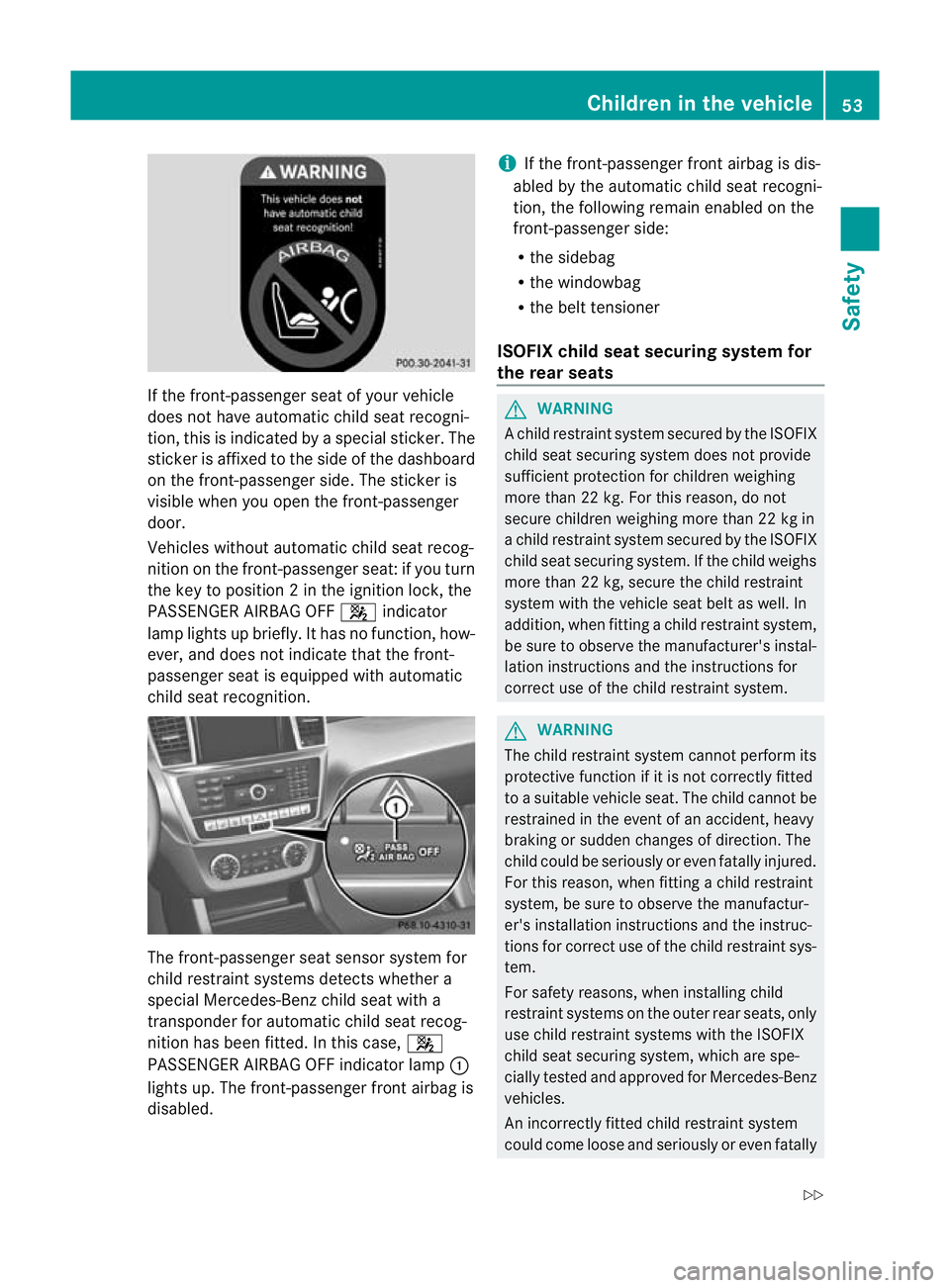
If th
efront-passenger seat of yo urvehicle
does no thave automatic child seat recogni-
tion, this is indicated by aspecial sticker. The
sticker is affixed to the side of the dashboard
on the front-passenger side. The sticker is
visible when you open the front-passenger
door.
Vehicles without automatic child seat recog-
nition on the front-passenger seat: if you turn
the key to position 2inthe ignition lock ,the
PAS SENG ER AIRBAG OFF 4indicator
lamp lights up briefly. It has no function, how-
ever, and doe snot indicate that the front-
passenger seat is equipped with automatic
child seat recognition. The front-passenger seat sensor system for
child restraint system
sdetect swhether a
special Mercedes-Ben zchild seat with a
transpo nder for automatic child seat recog-
nition has been fitted. In this case, 4
PASSENGER AIRBA GOFF indicato rlamp :
lights up. The front-passenger front airbag is
disabled. i
If the front-passenger front airbag is dis-
abled by the automatic child seat recogni-
tion, the following remain enabled on the
front-passenger side:
R the sidebag
R the windowbag
R the belt tensioner
ISOFI Xchilds eat securing system for
the rear seats G
WARNING
Ac hild restraint system secured by the ISOFIX
chil dseat securing system does not provide
sufficien tprotection for children weighing
more than 22 kg. For this reason, do not
secure children weighing more than 22 kg in
ac hild restraint system secured by the ISOFIX
chil dseat securing system. If the child weighs
mor ethan 22 kg, secur ethe chil drestraint
system with the vehicle seat belt as well. In
addition ,when fittin gachild restraint system,
be sur etoobservethe manufacturer' sinstal-
latio ninstructions and the instructions for
correct use of the child restraint system. G
WARNING
The child restraint system cannot perform its
protective function if it is not correctly fitted
to as uitable vehicle seat. The child cannot be
restrained in the event of an accident, heavy
braking or sudde nchanges of direction. The
chil dcould be seriously or even fatally injured.
For this reason, when fittin gachild restraint
system ,besure to observe the manufactur-
er's installatio ninstructions and the instruc-
tions for correct use of the child restraint sys-
tem.
For safety reasons, whe ninstalling child
restraint systems on the outer rear seats, only
use child restraint systems with the ISOFIX
child sea tsecuring system, which are spe-
ciall ytested and approved for Mercedes-Benz
vehicles.
An incorrectly fitted child restraint system
could com eloose and seriously or even fatally Children in the vehicle
53Safety
Z